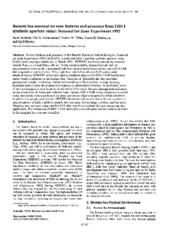Barents Sea seasonal ice zone features and processes from ERS 1 synthetic aperture radar: Seasonal Ice Zone Experiment 1992
Journal article, Peer reviewed
Permanent lenke
https://hdl.handle.net/1956/1070Utgivelsesdato
1999-07-15Metadata
Vis full innførselSamlinger
Originalversjon
https://doi.org/10.1029/1998jc900050Sammendrag
Sea ice features and processes in the Barents Sea were studied during the Seasonal Ice Zone Experiment 1992 (SIZEX92), a dedicated ERS 1 satellite synthetic aperture radar (SAR) field campaign carried out in March 1992. SIZEX92 was based around the research vessels Polarsyssel and Håkon Mosby. In situ oceanographic, meteorological, and ice measurements were made, coordinated with low-altitude aerial observations and ERS 1 SAR data acquired in near real time. Fifty-eight low- and full-resolution SAR scenes were obtained during SIZEX92, which provided a validation data set for ERS 1 SAR backscatter under winter conditions in the Barents Sea. Analysis of SIZEX92 data has provided geophysical insights, including a better understanding of Barents Sea ice edge freezing processes and ice edge development in response to atmospheric forcings. In particular, areas of new ice formation were found to be related to bathymetric features through their influence on the circulation of Arctic and Atlantic water masses. ERS 1 SAR image sequences revealed rapid, mesoscale variations in new ice areas and the ice edge in response to wind conditions. In addition to geophysical insight, SIZEX92 demonstrated some of the technical capabilities and limitations of ERS 1 SAR to identify new ice areas, the ice edge, ice floes, and ice types. Mapping new ice areas using satellite SAR data may be considered the most promising new application. The limitations of ERS-1 SAR-derived ice classification and ice motion estimates in the marginal ice zone are identified.
